Walt Disney Television Animation (September 19 2000), Walt Disney Home Entertainment (December 16 2008), single disc, 75 mins plus supplements, 1.66:1 anamorphic widescreen, Dolby Digital 5.1 Surround, Rated G, Retail: $29.99
Storyboard:
Remember Disney’s 1989 classic The Little Mermaid? Well, imagine Ariel had a daughter and flip the story around so that the young girl wanted to be a mermaid instead of a human and…presto! That is this movie.
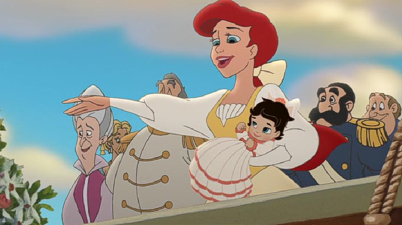
The Sweatbox Review:
I’m not sure if its because John Musker and Ron Clements’ take on Hans Christian Andersen’s The Little Mermaid was so definitive a version of the story back in 1989, but it seems this is the one fairytale property that Disney has had a really hard time trying to turn into a bona fide franchise. Unlike spin-offs for similar, of the era animated hits Aladdin and The Lion King, the commercial ambitions for the further exploits of the characters from Mermaid seem to eluded the creative forces behind such endeavors. Could it be because, since the original story that any follow-ups must adhere to is set under the sea, that this need to keep returning to the watery depths is what has prevented any additional stories to find their own fins, as it were, and swim free?
The enormous and somewhat unexpected success of the 1989 film immediately prompted a newly buoyant Disney Studio to expand their television animation division, itself enjoying a resurgence on the back of popular shows such as Gummi Bears and Duck Tales, the centerpieces of The Disney Afternoon, a programming block of the Studio’s animation. Seeing a spot for an animated series based on their latest hot property, Ariel’s Undersea Adventures quickly made its way to the screen by 1992 to accompany an extensive shipload of merchandise, also providing the template for the later Disney Princess businesses that would further exploit the growing line up of characters the Feature Animation unit was introducing in such films as Beauty And The Beast and Aladdin.

Poorly conceived and trapped in the rut of ostensibly being set before the events in the feature film were to take place, The Little Mermaid television program had trouble finding an audience and the series was short-lived, not even making it to a syndication-ready 65 episodes having been cancelled with only 31 editions in the can. Part of the problem was the character dynamics: personalities that are clearly set up in the feature and run through their own arc have to play with the dual conventions of reverting back to their earlier selves while still coming over as the appealing characters we grow to love in the movie. Sebastian is the main difficulty, having to be a friend to the mermaid but still without the warmth that he begins to show in the later-chronologically set events in the film, while villain Ursula is an even bigger fish for the writers to fry: we’re never in any doubt that her evil schemes could ever be successful because we know the movie’s events are still to come. Other events in the show have since become obsolete: there’s a clear version of how Ariel and Flounder are to have met that is completely ignored in the recent third film, the prequel Ariel’s Beginning.
Although the series didn’t find its water-wings, the overwhelming success of the original animated feature in a 1997 theatrical re-release (purposely promoted by Disney against Fox’s Don Bluth picture Anastasia) and subsequent 1998 home video and LaserDisc release, which sold millions more units than it had on VHS in 1990, proved that there was an audience ready to gulp up more of Ariel’s adventures. Disney’s practice of direct-to-video titles, which had begun with the Aladdin television compilation The Return Of Jafar and developed quickly from episodic assemblages to full-length stories such as the Beauty And The Beast interquel The Enchanted Christmas, had had enormous success with the Lion King follow-up Simba’s Pride, released to DVD with The Little Mermaid in Disney’s original series of Limited Issue titles.
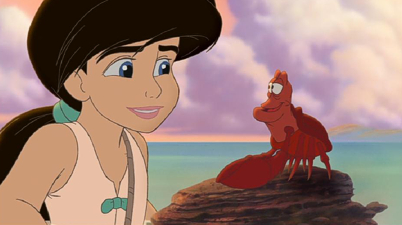
Looking for other recent properties they could exploit, a similarly styled sequel to Mermaid was a no-brainer, and the inevitable The Little Mermaid II: Return To The Sea came to disc in late 2000. Unfortunately the film didn’t do much to quash the feelings from many audience members that these Disney sequels were little more than retreads of the original films, but without the charm and, most strikingly, the quality. And quite fairly the accusation stands: although a sequel to Pocahontas had actually continued the Indian princess and John Smith’s story, Simba’s Pride had been little more than “The Lion King Again”, a trend that was sadly set to continue in Mermaid II and subsequent fare such as Lady And The Tramp II: Scamp’s Adventure.
The conceit is simple, essentially taking the original story and moving it on to “the next generation”, so here instead of mermaid Ariel wishing she had legs instead of fins and could escape from the waves, it’s her and Prince Eric’s young daughter Melody who learns of her mother’s watery heritage and decides it would actually be pretty cool to give up the legs, have fins and dive beneath the ocean. Ostensibly, that’s not such a bad idea for a continuation, but that we then get a complete Ursula rehash in the shape of her hitherto unseen sibling Morgana (except she’s thin this time, right, even if she’s still voiced – deliciously as ever – by Pat Carroll) who’s out for revenge for the death of sister from the end of the first film. The action having jumped some ten or twelve years since those events, one has to wonder why she’s waiting until now…?
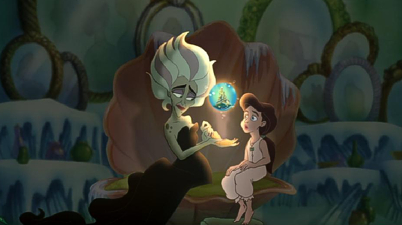
Okay…I’m obviously not in the little girl target audience for this kind of thing, but that’s no reason why the whole enterprise feels slapdash and totally lacking in originality or magic. It’s also too easy to argue that I’m not being aimed at; the original film was a fantastic achievement in crossing age and gender boundaries and indeed a lot of its repeat business was as a date movie that brought teenagers back to animation. I’m also, it must be said, quite a sucker for “chick flicks”, enjoying my fair share of such otherwise frivolous cinematic epics of the genre. I’m not even anti-Disney DTV, having praised and encouraged others to see the good in Scamp’s Adventure, Peter Pan: Return To Never-Land, The Lion King 1½ and others of this vintage. So how come Ariel’s return doesn’t stir up any positive reactions in me?
My concerns with the film begin seconds into it, after a fairly haunting opening few seconds which suggests this could be better than expected. Some fairly stiff seagull animation aside, Jodie Benson’ unmistakable Ariel’s voice drifts softly over the titles in the wind and it all feels rather eventful…but then we’re hit with the curse of the DTV level songs, in which I jest not, “orders” is coupled with “borders” and a main title flashes up that looks as cheap as one of those fairytale knock-off video versions that used to flood the market around Disney release times. The ever so earnest music and trite, trite, trite lyrics wouldn’t make it to off-off-Broadway, but here they are, snagging this feature’s opening screen time as it races through trying to re-introduce the world above and under the sea in just a couple of minutes. It tries to evoke a bit of excitement in an Annie type way, with the citizens of the aqua kingdom Atlantica preparing for Ariel’s return, but the cartooning is just so bland and the song so basic and mediocre, that anyone with half an inkling towards what used to stand for Disney quality could only come to the conclusion that the characters (and the filmmakers) are just going through the motions.
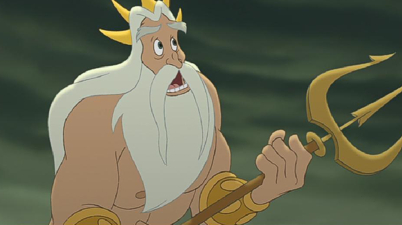
The uneven animation is perhaps the result of splitting production between three facilities (in Toronto, Vancouver and Sydney), but as usual for these outings, the supporting characters come off best in the film: Sebastian is a great personality, of course, who could hardly ever be screwed up, but it’s the comedy seagull Scuttle – again wonderfully realised by Buddy Hackett who brings an added life to the bird that’s not evident in the scripted lines – that really steals the few scenes in which he appears, more so than in the original picture. Ariel’s Dad King Triton was a run of the mill character anyway, but here he’s given little to do other than look off-model throughout; honestly, he looks as if some second rate book illustrator has gotten a hold of him. As will happen in the later prequel Ariel’s Beginning the use of “magic” has been misunderstood by the creative team, allowing Triton selective powers and Morgana the power to alter her surroundings just by appearance. In fact, her reveal here just highlights the lack of imagination or ambition on offer here: rather than something slowly building, or any real threat, she simply leaps out of the water with a not-so subtle darkening of the sky behind her, leaving Sebastian to hysterically provide exposition. “Ursula’s crazy sister!” he screams out, with Triton adding a “Morgana!” for good measure.

Out of everyone, Carroll’s villainess is again the best thing going on, but she’s basically such an Ursula clone in everything but shape that one must wonder why the writers didn’t come up with a way to simply bring her back…it would have been preferable to this “impostor”. As Ariel, Benson is as game as ever, bringing depth to a character with minimal dimensions anyway and suggesting some maturity in her since the events of the original film. With Morgana out for revenge, Ariel decides that daughter Melody can’t be allowed near the water for fear of danger (why that might stop the sister of someone who transformed herself into a human and came ashore is anyone’s guess, but it’s probably not wise to think about this too hard). Banished from the sea, it’s obviously not too long before Melody’s swimming with the fishes behind her parents’ back, and discovering the long-lost locket that grandpa Triton intended to give her on her first birthday. Now twelve, the girl’s activation of the locket inadvertently alerts Morgana to her presence, and the sea witch is all-too ready to answer Melody’s questions about where she came from…
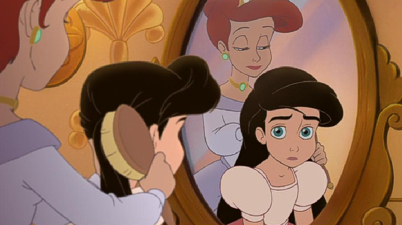
There are, among all the lightweight aspects of the film, some nice moments: long-time Alan Menken collaborator Danny Troob’s score does a lot to float the film overall, and Melody herself is often very well animated, an appealing character who shares a couple of warm and well-rounded scenes with her mother Ariel. But these quiet instances are few and far between, unbalanced by some weaker storytelling and over-hysterical songs, surprisingly penned by the otherwise dependable Silversher & Silversher. For A Moment, in which Morgana grants Melody’s wish to be a mermaid, is just awful, cutting between Melody’s fin practicing and Ariel’s search for her, but just coming over as disjointed and desperate. Ariel herself is appallingly off-model at one point, the mermaid famed for her singing voice straining and over-acting so much she actually looks dreadfully ill, while Triton’s transformation of Ariel from human to mermaid apparently also includes fashion sense, swapping her maid’s clothes for the more familiar sea-shells combo. Melody’s realisation that she now has fins is marked by more banal lyrics: “Okay, get a grip, get the hang of this flipper / It’s like slipping two feet into one big huge slipper”, followed by “For a moment, I can shine / Got a grin and a fin that works fine / My fingers are wrinkly and I really don’t care / If all of my curls have curled out of my hair”…Howard Ashman this most certainly ain’t!
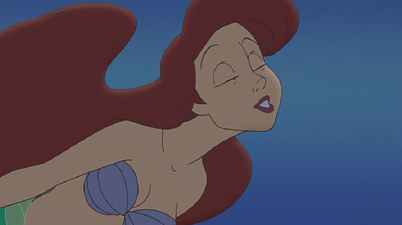
Return To The Sea attempts to bring some intended humor to proceedings: a total 180 degree turn into uncharted waters comes halfway through with the introduction of some comedy penguins, in particular a Joe Pesci-type wiseguy, that doesn’t exactly unbalance the film as he does try to make it his own. Kudos, at least, for picking penguins before the rest of the animated world had to start featuring them in every other feature release out there (though after The Pebble And The Penguin), and one has to note a similarity between these guys and that Madagascar quartet. Rejected penguin Tip and walrus Dash join Melody on her undersea adventure, rather pointlessly it has to be said other than to then simply be around to conveniently help out during the climax, before the end credits acknowledge all too well the lack of decent songs here, choosing an unoriginal, overlabored but otherwise carbon copy pop cover of Part Of Your World by Chely Wright as its big finish.

Ultimately, we’re to believe that the recent prequel Ariel’s Beginning was some sort of “apology” for the mistake made in crafting this movie, but I have to say that I think they are apologising for the wrong attempt. Whereas Return To The Sea certainly earns some “cheapquel” stripes with pride, it remains a much more rounded outing than Ariel’s Beginning, which was a nonsensical borefest that actually dents the franchise in many more ways than this ever could. At least Return To The Sea has the benefit of following the original feature film, which is both a blessing and a curse – good in that it can allow the personalities to grow and a story to progress without any hindrances inherent in having to foreshadow later events, but unfortunate in that it sadly has to do exactly that: follow an inimitable strike of lightning. And that, perhaps, is the point.
Is This Thing Loaded?
Now a Disney FastPlay disc, The Little Mermaid II skips into pre-programmed play, serving up Sneak Peeks for current and upcoming DVD and theatrical releases including Pinocchio’s Platinum Edition, The Princess And The Frog teaser, Space Buddies, Oliver & Company 20th Anniversary, The Cheetah Girls: One World, the Disney Movie Rewards and, from their own menu option, previews for Beverly Hills Chihuahua, Secret Of The Magic Gourd, TinkerBell And The Lost Treasure a Think Fast trivia video game, Wizards Of Waverly Place, Schoolhouse Rock!: Earth and Winnie The Pooh And A Musical Too.
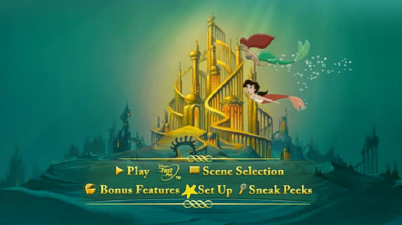
Carried over from the previous 2000 release are a series of Games & Activities, including The Little Mermaid II DVD Storybook, narrated by Jodi Benson (“the voice of Ariel” the cover reminds us) and basically running through the story, such as it is, again in either read out loud or read-along versions. Also as before, the What Am I? Sea Creature Game simply serves up some clues to help the player select, from three A, B and C choices, the answers, which lead to a little bit of info on the real life creatures that inspired the characters in the movie for some healthy educational value. This is joined by the similar Little Mermaid II Trivia Game, again asking a multiple choice question on scenes from the movie.
All these current Disney reissues boast an added set-top game and here’s it’s the new Little Mermaid II Underwater Mer-Venture Challenge, which is frankly so dumb it hurts! A three-level extravaganza, the opening instructions are as complicated as the eventual activity is redundant: it’s another of those pre-programmed video clips that suggest the player can control the characters via their remote, even though the animation has all been worked out already. First up is a swim through the ocean with Melody, in which the player must “guide her”…right. A wrong tap on the keys will ask if you want to “Play Again?”, which those making it to the next level, a music-making chore, most certainly will not. It didn’t make the slightest bit of sense, had no point, and I gave up there and then.
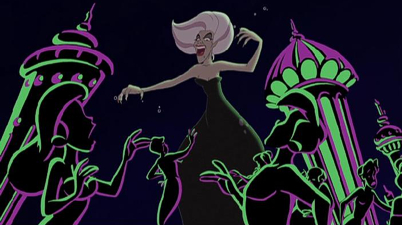
If that was the only addition to the disc, many would feel cheated, but although these extras apparently drop an original preview for the film from its first release, it is actually replaced with something better, for once: a newly discovered Deleted Song Gonna Get My Wish which runs a couple of minutes in a letterboxed 4:3 format and in completed full color animation to boot! I’m always concerned that the trims on these direct to video films are more the case of fitting them into later broadcast slots on commercial television rather than being cut for pacing or artistic reasons, and such is the case again here: much needed in the film (it would have plugged a musical gap in a half-hour section without songs) and for her character to make an Ursula-sized impact is a song for villainess Morgana – and this is almost it. Villain songs are always a highlight of any animated musical and, while it’s sometimes as awkward as the other songs in the movie, why it ended up on the cutting room floor is as usual anyone’s guess…with some of the finest animation on the production, it’s simply one of the best moments not in the movie!
While one has to smirk at the “newly discovered” (read: “saved for later”) hyperbole description of the deleted song, it does add some genuine value to the package, as does the inclusion of the bonus short Merbabies, the 1938 Silly Symphony again presented here from an unrestored print. This sequel to the 1936 short Water Babies seems only to have been bundled in here because of the mer-connection, but it’s also interesting to Disney buffs as the only slice of Disney animation not to have been completed at the Studio, a distinction the short had until the 1980s when Winnie The Pooh And A Day For Eeyore was animated out of mouse-house. Walt hadn’t been too excited at having to bow to distributor RKO’s requests for more of the same, and farmed out the eight and a half minute Merbabies to his old pals Hugh Harman and Rudy Ising, established at rival Metro-Goldwyn-Mayer Pictures. The Harman-Ising cartoons of the period were consistently compared to Walt’s cuter Symphonies so the intricately detailed quality is justly on the same level. It’s a typical Disney production in all but production background (Hugh and Rudy don’t even get screen credit) and a sneezing whale even predates Monstro’s appearance in Pinocchio two years later. Of course it’s animated much better than the main feature, but those eager to own it would be better to source the Walt Disney Treasures collection in which it is included in finer quality.
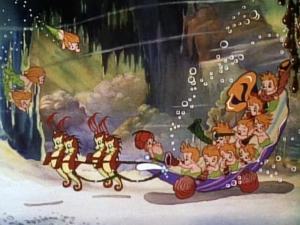
Case Study:
Like the movie it promotes, the cover art here is as bland as it dares. The original issue of Return To The Sea somewhat aped the original posters for The Little Mermaid, so originality was never the order of the day as far as this title is concerned. This time around it feels even less inspired, Melody and Ariel swimming around the main title while clipart editions of Sebastian and a young Flounder seem pasted on (Flounder being actually a Dad in this one and much older in appearance). With a bit of space at the bottom of the sleeve, replicated on a glossy embossed slipcover that at least adds a touch of sparkle, we get an ever so tiny and out of the way Morgana just about edging herself into the bottom left and, on the right, the usual proud image of Triton that may as well be from any number of other Mermaid illustrations. Topping things off is the pointless as can be “Meet Ariel’s Daughter” banner along the top: could it ever get more basic? Well, yes, on the back we don’t get screenshots but a trio of publicity shots and another Sebastian that looks like he’s actually been swiped from a moment in the third film, Ariel’s Beginning. Finally, Bill Hoffman from the New York Post lies with his comment that this is as good as the original film. Maybe he got them confused?
Ink And Paint:
The cover states a standard 1.66:1 aspect ratio, but The Little Mermaid II: Return To The Sea actually fills the entire 1.78:1 display, suggesting that this was never intended as anything more than a direct-to-video outing.

For some strange reason the end credits seem to have been captured from a film source, noticeable from their slightly skewered appearance, gate weaving and amount of grain that’s introduced into the image as they scroll. But what comes before is digital perfection, showing up all the inadequacies in the draftsmanship as clear as day. There are some nice touches as mentioned, but Mermaid II simply struggles to match its predecessor on every level.
Scratch Tracks:
Coming near the big boon of early DVD sales when video premiere companies were trying to impress those with home theater setups to purchase these releases, the Disney DTV soundtracks have always been theater-quality mixes, also attempting to gloss over any inadequacies in the visuals with good sound. Mermaid II therefore sounds as good as most, though it’s not as involving a soundtrack as the theatrical original, which had added ambience and an attention to detail missing here. It’s perfunctory enough and stands up well almost a decade later, with Danny Troob’s orchestrating background helping his score sound fuller than it might have, and decent dialogue and effects separation. It didn’t rock my boat, but it should float yours. English, French and Spanish subs and dubs are bundled in.
Final Cut:
Although The Little Mermaid II: Return To The Sea never sinks as low as other Disney DTVs in that output’s short-lived history (those awards would go to the poor Cinderella anthology Dreams Come True, the diabolically embarrassing Hunchback Of Notre Dame II and the mermaid’s most recent shipwreck Ariel’s Beginning), it’s still a far cry from the best the unit had to offer. Obviously created for money rather than any artistic ambitions, this finds the Walt Disney Television Animation unit at an early stage, long before becoming the dedicated DisneyToon Studios and still finding their feet in balancing economic demands and quality, a balance they would just begin to start finding and feel confident with when the new Disney regime change pulled the plug. While I was a champion of allowing the unit to continue on their own, first run films, unfortunately this is exactly the kind of project that gave them a bad name in the first place. While Return To The Sea is fairly inoffensive, forget Disney’s marketing of any Little Mermaid “Trilogy”: Ariel’s adventures begin and end with the 1989 feature film…everything else is superfluous.
 | ||
 |






